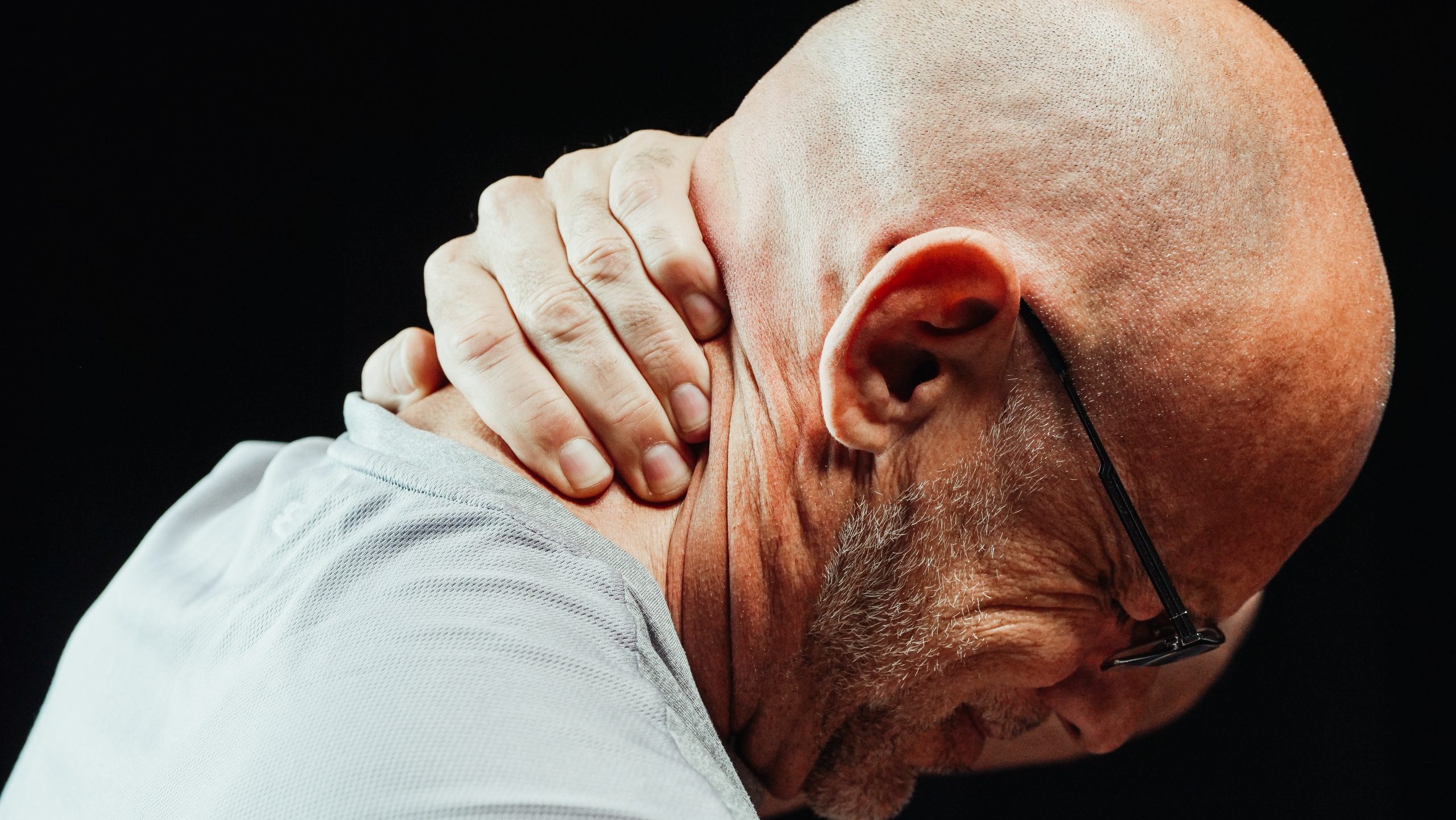While no one wants to experience pain, sometimes, it’s completely unavoidable. Maybe you woke up with a knot in your upper back. Or perhaps you noticed a gradual ache begin to appear in your upper back throughout various parts of your day.
Whatever the case may be, upper back pain isn’t ideal. And it can definitely throw a wrench in your daily activities — even disrupting your sleep. So, what can you do about it? And what is causing your upper back pain in the first place?
Which Back Muscles Cause Upper Pain?
Generally, upper back pain is pain that occurs anywhere between the lower to mid ribcage at the neck. While not as common as lower back pain, it can still be distracting and deter you from enjoying your favourite activities or sports.
Usually, upper back pain is a result of some kind of postural deficit. If you hunch forward at a desk all day or continually arch your neck and upper back downward to peer at your phone, this can place excessive stress on the muscles and structures that make up your upper back.
This typically involves the trapezius muscles, the levator scapulae muscles, the rhomboid muscles, and sometimes the muscles of the rotator cuff. These muscles may develop tightness or strains due to poor posture (leading to muscle weakness) or repetitive movements (which irritate the muscles).
However, upper back pain isn’t always a muscular problem. Similar to lower back pain, joint dysfunction can play a prominent role in some upper back pain cases.
The joints of the thoracic spine can experience injury and natural deterioration that happens as you age. This may lead to painful bone-on-bone grinding or vertebrae disc issues, such as in the case of arthritis or herniated discs.
Although rare, if you’re experiencing pins and needles in the abdomen or chest, chills, fever, decreased coordination, balance issues, or headaches alongside your upper back pain, it’s important to seek out immediate medical attention. These symptoms are often the result of serious injury or infection.
How Do You Relieve Upper Back Pain?
So, what can you do to alleviate your upper back pain? Initially, rest combined with heat or ice (or both) can help reduce your pain. Heat, in particular, can also help relax tight and aggravated muscles, allowing you to relax.
When applying heat or ice packs, always ensure you place a cloth between your skin and the hot or cold compress. Leave the ice or heat on for 15-20 minutes, with a minimum of 45 minutes in between applications.
At the same time, you may want to consider over-the-counter medications to reduce swelling and pain. Common types of over-the-counter medications that may help include aspirin, ibuprofen, naproxen, and acetaminophen. As with any medication, it’s critical to follow the instructions provided on the labels to avoid side effects.
Booking a massage or physiotherapy appointment (or both) may also help eliminate your pain and reduce muscular tightness. Massage can help increase blood flow to the area and relax muscular tension. Meanwhile, physiotherapy can help diagnose your upper back pain and determine an appropriate treatment plan, including prescribed exercises.
If you’re not ready to book an appointment quite yet, you can also try out the exercises below to help reduce your discomfort and strengthen any weak muscles. When performing any exercise, ensure you only go to the point before pain. If pain increases, stop the exercise.
Exercises That Help Upper Back Pain
Upper back pain exercises target the postural and shoulder muscles, helping to balance out any weaknesses, and help loosen up any tight muscles. So, what kind of exercises should you try? We’ve got a few ideas!
Upper Back Strengthening Exercises
These strengthening exercises target the muscles of your upper back, including your trapezius, rhomboids, and more. Make sure each movement is slow and controlled to prevent any aggravation or further injury.
1. Shoulder Blade Pinches
Sit up or stand tall. Keeping your shoulders down and relaxed, gently pinch your shoulder blades together. Hold for 5-10 seconds, then release. Repeat this for 10-12 repetitions and do this 2-3 times a day.
2. Seated Row
Sit in a chair and wrap a resistance band around a stable object in front of you. Hold each end of the band in each hand. Begin with your arms straight in front of you and with a little bit of tension in the band. Bend your elbows, pulling the band toward you, and bring your elbows along the sides of your body. At the same time, make sure you pinch your shoulder blades down and back.
Pause, then slowly bring your arms back to the start. Repeat for 10-12 repetitions and do 2-3 sets. Perform this exercise every other day.
3. Wall Angels
Stand facing away from a wall and press your back right against it (It’s okay if your feet are about a step away from the wall for this exercise). Place your arms against the wall at shoulder height, bending your elbows to 90 degrees and so that your fingertips are pointing up to the sky.
Slowly move your arms upward, keeping them flat against the wall, and bring your hands to almost touch. Slowly bring them back down and repeat for 10-12 repetitions. Do 2-3 sets. Perform this exercise every other day.
4. Superman ‘W’
This is a special take on the basic “superman” exercise. Lay face down on a yoga mat or a comfortable surface. Extend your arms straight in front of you. Bend your elbows and bring your arms back so that you’re pinching your shoulder blades down and back and your chest is slightly off the ground. Hold for 10-15 seconds, then release. Repeat for 5-10 repetitions and do 2-3 sets. This is another one you can choose to perform every day.
You can also add weights by holding small dumbbells in your hands. If you begin to add resistance, aim to perform this exercise every other day.
Upper Back Stretches
Stretching can help relieve muscle knots and tension. The following stretches can even be wonderful additions to your weekly routine. Aim to perform each of them every other day or as needed.
1. Neck Rolls
This stretch is super simple and can easily be performed while sitting at a desk. Simply allow your head to drop forward and then move in a full circular motion one way, then the next. Do this 3-5 times. You should feel the muscles loosen a bit as you slowly move your head.
2. Levator Scapulae Stretch
This is a great stretch to perform every day, especially if you’re sitting at a desk for 8 or more hours.
Start by placing your right hand under your buttocks. Use your left hand to pull your head down and your gaze toward your left armpit. You should feel a stretch through the right side of your neck and upper back. Hold here for 20-30 seconds, then switch sides.
3. Trapezius Stretch
The trapezius stretch is very similar to the levator scapulae stretch but with one slight difference.
Start in the same position as the levator scapulae stretch with your right hand under your buttocks. Use your left hand to pull your head toward your left shoulder. Keep your gaze forward. You should feel a stretch along your upper shoulder and back. Hold here for 20-30 seconds.
4. Rhomboid Stretch
Clasp your hands together with your arms straight in front of your and your palms facing inward. Bow your head slightly in between your arms. You should feel a nice stretch through the centre of your upper back. Hold here for 20-30 seconds.
5. Cat & Cow Stretch
Begin on all-fours. Start by arching your spine down and bringing your gaze up high to the sky. Pause for a few seconds, then bring your head in between your arms while arching your back upward. Hold here for another few seconds before switching again. Go back and forth about 5-10 times, holding for a maximum of 30 seconds in each position.
6. Pec Stretch
Opening up the chest muscles can help realign your posture by bringing the shoulders back. Find a corner or a doorway to perform this exercise. Place your forearms and palms at shoulder height on the doorframe or wall. Step or lean inward. You should feel a stretch through the chest muscles. Hold here for 20-30 seconds.
Say Goodbye to Upper Back Pain for Good
Upper back pain doesn’t have to become your norm!
At Corydon Physiotherapy, we can help you alleviate your pain and move forward into a future where pain isn’t holding you back from enjoying your life. With massage, acupuncture, and physiotherapy services, our team can help you tackle upper back pain in various ways.
Book your appointment today by calling us at (204) 925-0380, emailing us at corydonp@mymts.net, or by using our self-serve online booking system.




